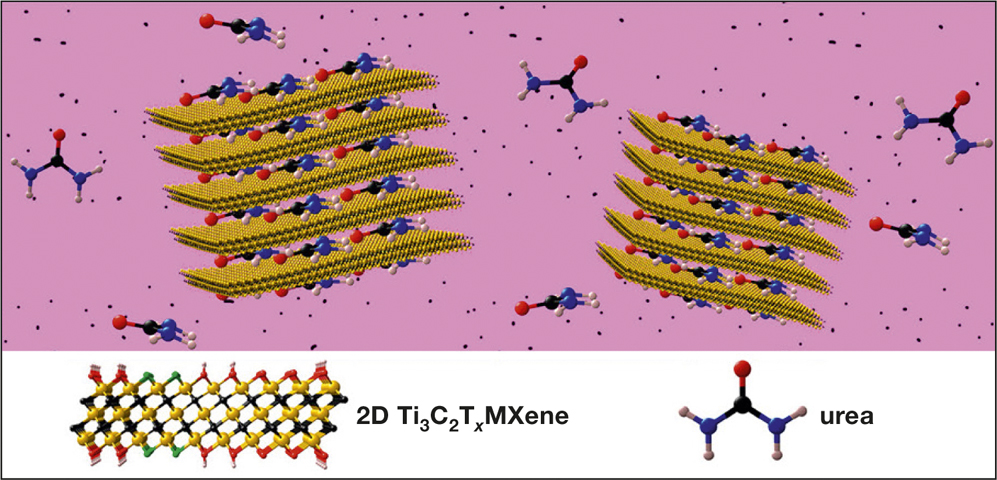Atomically thin two-dimensional (2D) materials are a burgeoning class of structures that now encompass numerous chemistries beyond graphene. They offer highly versatile properties and promising capabilities that transcend the limits of traditional materials. While certain obvious applications immediately jump to mind for these materials—electronics, memory chips, and energy storage—novel biomaterials also stand to benefit from 2D nanostructures. In particular, wearable artificial kidneys, which conduct round-the-clock dialysis for patients with end-stage renal failure, require new sorbents in order to become sufficiently lightweight, portable, and efficient to provide this lifesaving treatment.
In order for wearable kidneys to efficiently function, they must regularly remove urea molecules from the dialysate solution, which constantly collects these toxic molecules out of blood during dialysis. Traditional methods require catalytic decomposition and outgassing of carbon dioxide and adsorption of ammonia, another decomposition product. This solution is not acceptable and will not work for a proper wearable medical device. On the other hand, 2D materials can effectively trap urea molecules between their atomically thin sheets—but only if the surface chemistry, as well as the interatomic spacing of the laminates, is properly tailored for this process.
A relatively new class of 2D transition-metal carbides and nitrides, called MXenes, appears well-suited for this task. The atomically thin delaminated layers of MXenes are composed of metals (such as titanium) bonded to carbon and/or nitrogen, and terminated with oxygen, hydroxide, or fluoride surface groups. They resemble clays and can accommodate molecules such as water and urea. A team of materials researchers from Drexel University, alongside visiting scientists from Guangxi Medical University and Huazhong University of Science & Technology, and collaborators from Cedars-Sinai Medical Center and the University of Brighton, used this MXene material to remove almost all dissolved urea from dialysate solutions and to absorb 22 mg of this waste material per gram of sorbent. The researchers published their breakthrough in a recent edition of ACS Nano (doi:10.1021/acsnano.8b06494).
Drexel professor Yury Gogotsi, the principal investigator behind the work and one of the original discoverers of MXene in 2011, emphasized the significance of this work: “MXenes perform well in many biomedical applications ranging from brain electrodes to cancer treatment (photothermal therapy and drug delivery) and urea adsorption. Now we need to find which of more than 30 available compositions works best and tune it for this specific sorption application in a wearable kidney.”
The researchers found that MXenes based on a 3:2 titanium-to-carbon ratio and terminated with hydroxyl and oxygen surface groups adsorb urea at the highest rates and in the highest amounts. The material selectively removed 99% of the waste product from aqueous solutions of urea and 94% from dialysate (of chronic kidney disease patients). Once the researchers increased the temperature from ambient to the normal human body level of 37°C, the absorption capability of the MXene increased two-fold. The sorbent did not break down any of the adsorbed urea into carbon dioxide or ammonia and, therefore, eliminated the complex need for the wearable kidney to process and remove these gas products. This material must exhibit no toxicity and must not adversely impact blood plasma during its operation as a biomedical sorbent, and the biocompatibility of MXenes was confirmed with live blood cells.

Atomically thin 2D MXenes exhibit optimal interlayer spacing and surface chemistry to efficiently remove urea from the bloodstream and operate as a sorbent in an artificial wearable kidney. Credit: ACS Nano.
The MXene family of 2D materials is highly versatile, and its promising efficacy as a sorbent in artificial kidneys is likely to increase even further in follow-up research endeavors. Next, scientists will look to further optimize the materials structure, design a wearable device, and, eventually, complete clinical trials of successful prototypes. As the research community aims to find novel solutions for major healthcare problems, 2D materials are emerging as a powerful tool that is anticipated to gain prominence in artificial organ implants, wound treatment systems, drug delivery vehicles, and other essential components of this research field.


